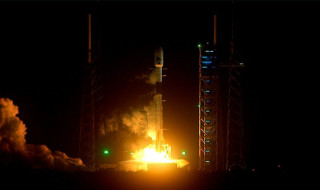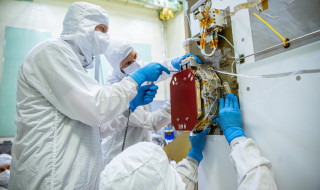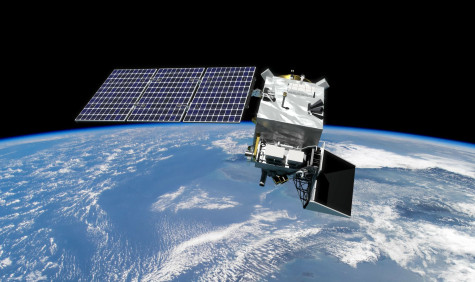"Thanks to this new instrument, we can better predict the rate of global warming"
A new piece of the climate puzzle
What role do clouds and particles play in global warming? That is what an instrument developed in the Netherlands, SPEXone, on board a new NASA climate satellite, is exploring. The data collected by SPEXone will be processed and stored at SURF and made available to the scientific community.
Key facts
Who: Otto Hasekamp
Function: Researcher
Organisation: SRON
Service: High-performance dataprocessing platform Spider
Challenge: Converting detailed light measurements to aerosol properties is a very computationally intensive process
Solution: Around 50 terabytes a year of data are processed and stored on the Spider platform, which is ideal for large, structured data sets
Tension at the launch base
It is a cloudy night on February 8 at Cape Canaveral in Florida. Together with his colleagues and people from Airbus and NASA, SRON researcher Otto Hasekamp sits in the open air to watch NASA launch the new PACE satellite. On board is the measurement instrument SPEXone, which Hasekamp and his team have been working on for six years. "Beforehand, I didn't think: this will go wrong. But once you are sitting there at that moment, you feel the tension: this had better go well..." For a moment, there is complete silence at the launch base. Then the rocket takes off into the sky with a huge flame and a lot of smoke. The ground shakes and the sky lights up. ""Our relief was great. Yes, that was quite special," recalls Hasekamp.

Otto Hasekamp (SRON): "On SURF's Spider platform, we process the data in different ways and then choose the best approach, so that we quickly have a good data product for the users."
Climate change research
With the PACE mission, NASA is researching climate change by using various instruments to study the ocean and atmosphere. From hundreds of kilometres above Earth, these instruments examine the impact of tiny particles in the water and air invisible to the naked eye. SPEXone specifically investigates what role clouds and aerosols (small dust or liquid particles) play in global warming.
Warming up even faster
Aerosols are a form of air pollution. They can consist of sea salt, desert dust, soot or ash. They also affect the climate: they cool the atmosphere because they reflect sunlight. Water can also condense on aerosol particles, creating more cloud droplets. Those clouds then reflect more sunlight, which also has a cooling effect.
"But we don't know how big that cooling effect is," says Hasekamp. "So we also don't know to what extent aerosols counteract global warming from greenhouse gases. This makes it difficult to predict the climate for the future. If the air becomes cleaner in the coming years because we reduce polluting industries, the global warming could accelerate even more."
Contradictory
It sounds contradictory: as a consequence of making the air cleaner, the atmosphere heats up. "But you have to do it, because air pollution is unhealthy. This new instrument, and the others on PACE, are going to provide some important pieces of the puzzle. This will help us better predict the amount of global warming."

The ground shakes and the sky lights up as the PACE satellite is launched
Available for science
SPEXone was developed in the Netherlands by SRON, the Netherlands Space Institute in Leiden, in collaboration with Airbus Netherlands. The data sent by the instrument to Earth over the next few years will be processed and stored on SURF's systems and then made available to the scientific community.
Reflected light
So how can the instrument observe these microscopic aerosols from such an altitude? "SPEXone actually measures the light reflected from aerosols," Hasekamp explains. "How the light is scattered, how much light it reflects, with what colours and from what angles, and how much light it absorbs: these all tell us something about the particle's properties, such as its size. To convert those measurements of light into aerosol properties, we have developed all kinds of algorithms. These run on Spider, SURF's data processing platform."
Computing-intensive
Converting light to aerosols is a computationally intensive process. Every piece of earth measuring 5 by 5 kilometres is gauged, and for each piece the measured light radiation is translated into aerosol properties. "NASA converts the data into a readable format and then we get the data to SURF. That will involve about 50 terabytes a year."

Engineers from SRON and Airbus Netherlands mount SPEXone onto the PACE satellite
Especially at the beginning of such a mission, a lot of things need to be optimised about those processing algorithms. "On the Spider platform at SURF, we do what we call 'scientific processing': processing the data in lots of different ways and then choosing the best approach. This allows us to quickly create a good data product for the users. These are SRON researchers, but also others who want to use the data, such as European research consortia."
The future of our planet
Minuscule aerosols, so far the big unknown in climate models, are the key to unravelling the complex interplay of elements in the atmosphere. Meanwhile, the first measurement results are starting to come in at SURF. In the coming years, the PACE satellite will continue to make its rounds around the Earth, to shed new light on the future of our planet.
Product page
Tropomi: measuring greenhouse gases for the past six years
For about six years, the measuring instrument Tropomi, also developed by SRON, has been orbiting Earth aboard the European satellite Sentinel-5P. Tropomi measures the emission of gases, and SRON mainly examines data on carbon monoxide and methane, a greenhouse gas. These data are also processed at SURF. Hasekamp: "That is another part of the climate puzzle. Methane warms the earth and aerosols cool it."
Further reading:
- SRON website: NASA launches climate satellite with Dutch particulate meter
- NASA website: NASA Launches New Climate Mission to Study Ocean, Atmosphere
Text: Josje Spinhoven
Photos: NASA, SRON
